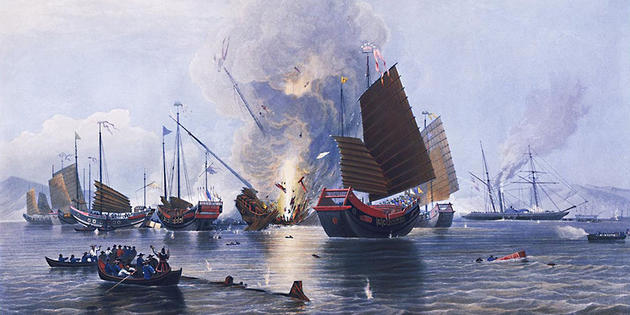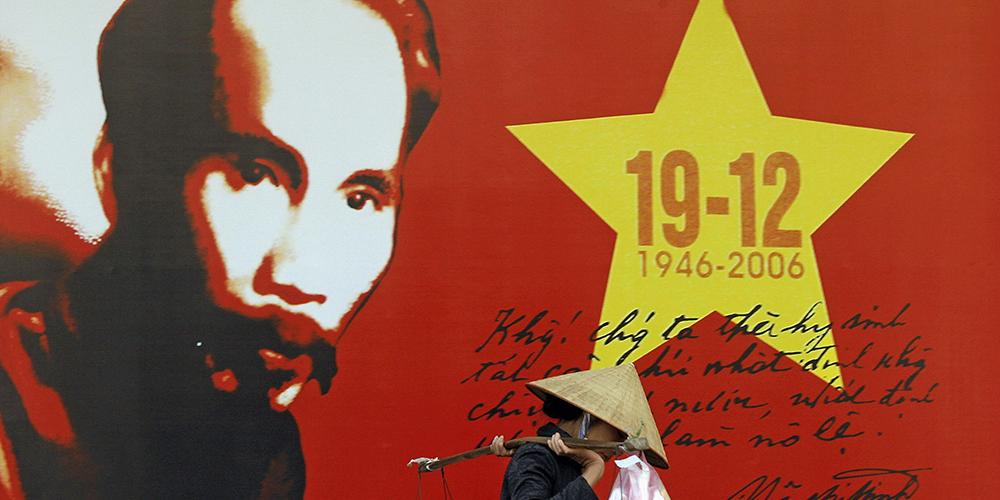
Vietnam After the War
Overview
Download as PDFPrologue: The End of the “American War”
On April 30, 1975, the last of America’s wartime personnel in South Vietnam boarded crowded boats and helicopters in a frantic attempt to flee the country. That same day, North Vietnamese tanks crashed through the gates of the Presidential Palace in Saigon. The palace was the seat of the South Vietnamese government, which the Americans had supported and the North Vietnamese had fought against. When North Vietnamese officers entered the palace, South Vietnam’s president told them he was ready to hand over power. They reportedly replied, “You cannot give up what you do not have.”1
The Vietnam War, or what is known in Vietnam as the Resistance War against the Americans, was over.
 Image 1: North Vietnamese tanks crashing the gates of the Presidential Palace in Saigon, 1975.
Image 1: North Vietnamese tanks crashing the gates of the Presidential Palace in Saigon, 1975.
The war’s toll was immense. The country’s infrastructure was ravaged by bombing and landmines, and parts of its otherwise lush landscape had been stripped by toxic chemicals like Agent Orange. As many as two million civilians died in the conflict, along with 1.3 million Vietnamese soldiers. Most of these soldiers died fighting for or alongside North Vietnam.2 But for all the losses North Vietnam had to absorb, its government and its allies in the south had reason to feel triumphant. They had “prevailed against all odds,” says historian Christopher Goscha, first beating the French in a violent war of de-colonization, then beating the Americans in one of the most brutal conflicts of the Cold War.3
Introduction: The Challenges of Reconciliation
Civil wars result from, and sometimes deepen, divisions within societies. As Goscha observes, those divisions do not simply disappear once the fighting stops.4 This was the case in Vietnam. Although some people in South Vietnam welcomed reunification and “liberation,” not everyone shared the feeling of triumph. For some, the war’s end raised uncomfortable questions: What kind of government would they have? Would the south have autonomy from the communist north? And what would happen to the people the communists viewed as enemies, such as capitalists and those who were associated with the South Vietnam government and its American or French backers?
The fall of Saigon in 1975 paved the way for the long-awaited reunification of Vietnam. But reconciliation—“healing the wounds and divisions of a society in the aftermath of sustained violence”—was a bigger challenge.5 One thing standing in the way of reconciliation was the North Vietnamese government’s deep suspicion of many people in the south and their doubts about southerners’ loyalty to the communist regime. As will be discussed later, its approach to building a sense of loyalty was often heavy-handed and often had the effect of alienating people rather than winning them over.
The story of Vietnam after the war can be told from many different perspectives. Here, we focus on one of those perspectives: that of the southerners who were made to feel that their lives before 1975 were a crime that needed to be punished, or a sin for which they needed to atone. We look at how they responded to life under a new system; some adapted, some found safe ways to resist, and some decided that their best or only hope was to leave to make a new life elsewhere. We also look at the dramatic changes that have taken place in Vietnam since economic reforms were introduced in 1986— changes that, according to recent surveys, have made Vietnam one of the most optimistic societies in the world. The changes have been so dramatic that Vietnam is now luring back some of the people who left—people who believed that post-war Vietnam had nothing to offer them.
Background: The Road to War and Partition
In May 1975, the North Vietnamese government faced the daunting task of stitching back together a country torn apart by decades of war. This rupture had its roots in the period of French colonization (1858–1954), a bitter experience for the vast majority of Vietnamese that gave rise to various pro-independence movements. The most significant of these was the Indochinese Communist Party created by nationalist leader Ho Chi Minh in 1930. During the Second World War, the Japanese occupied Indochina, but kept the French in place to administer Vietnam. Meanwhile, in 1941, Ho Chi Minh secretly created the Vietnamese Independence League, called the Viet Minh, but did not have an opportunity to seize power until 1945. In March of that year, the Japanese overthrew the French in Indochina, but then then surrendered to the Allies five months later. The surrender created a power vacuum that allowed the Viet Minh to seize power in the northern city of Hanoi. On September 2, 1945, Ho Chi Minh declared the country’s independence, naming it the Democratic Republic of Vietnam.
France, however, was not willing to give up its profitable colony. From 1946 to 1954, it fought the Viet Minh in a conflict now referred to as the First Indochina War. At first, the French had the upper hand, but the Viet Minh wore them down, dealing them a decisive blow in 1954 in the Battle of Dien Bien Phu. Shortly after that, the world’s major powers opened negotiations in Geneva, Switzerland, to try to bring an end to the war.
There were two outcomes of the Geneva Conference. First, a ceasefire ended the war between France and the Democratic Republic of Vietnam; however, this also resulted in the country being divided at its “waist” (the 17th parallel) (see Map 1). Ho Chi Minh’s communist Democratic Republic of Vietnam took control of the zone to the north of the 17th parallel, while the State of Vietnam, created by the French in 1949 and increasingly supported by the Americans, administered the south. This partition was intended to be temporary.
The second outcome was an agreement by the two Vietnams to hold elections in 1956. These elections, it was believed, would unite the country under one of the two governments (Ho Chi Minh was heavily favoured). But this was not to be. In 1955, an anti-communist nationalist in the south named Ngo Dinh Diem transformed the State of Vietnam into the Republic of Vietnam and opposed unification with the communist north.6 The existence of two Vietnams was now more entrenched: a communist North Vietnam and an authoritarian non-communist South Vietnam.
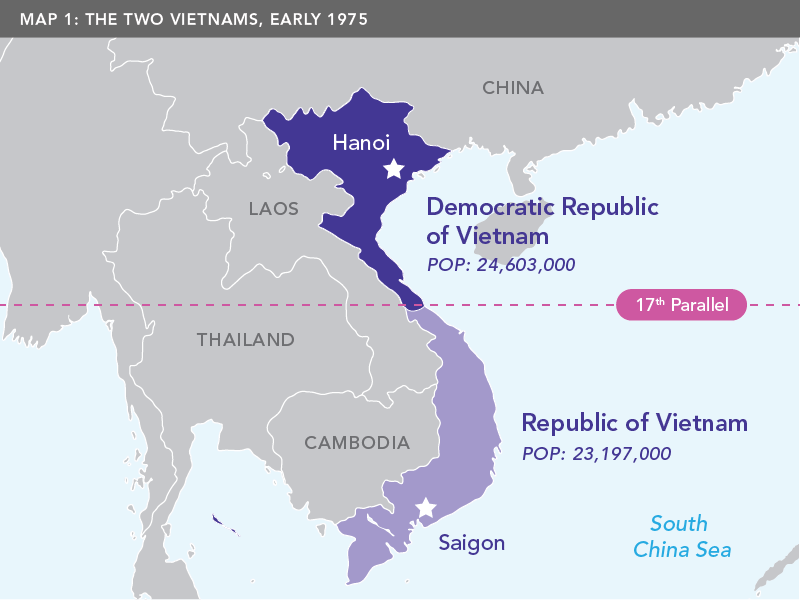 Map 1: The Two Vietnams, Early 1975.
Map 1: The Two Vietnams, Early 1975.
By 1960, a civil war was brewing, especially after the North created the National Liberation Front (NLF), a political organization and army, better known as the Viet Cong, in the south. The NLF included both communists and non-communists, and its purpose was to bring down the Ngo Dinh Diem government and unify the country on the North’s terms. As the Viet Cong expanded its control over the south, the U.S. responded by sending more military advisers. Worried that Ngo Dinh Diem was failing to stop the communists from taking over, U.S. President John F. Kennedy supported the South Vietnamese military’s overthrow of Ngo Dinh Diem in 1963. Neither Diem nor Kennedy would survive the year. Diem was assassinated by his own military on November 2, 1963, and Kennedy was killed in Dallas three weeks later.
Following Kennedy’s assassination, Lyndon Johnson became the new U.S. president. In 1965, the United States intervened directly in Vietnam by sending troops to South Vietnam. The Second Indochina War—also known as the American War—had begun; it would not end until the United States withdrew and South Vietnam fell to the communist-run Democratic Republic of Vietnam in 1975.
Consolidating Political Control
The North and its allies’ defeat of the Republic of Vietnam cleared the way for the long-awaited reunification of the country. Soon after that, the North Vietnamese government took several steps to consolidate its political control over the south. This included eliminating potential rivals, “re-educating” those who were suspected of disloyalty, and preventing other ideologies and beliefs from competing with socialism.
Removing rivals: The North quickly made clear that previous agreements for sharing power with allied groups in the south were no longer valid. According to the 1973 Paris Peace Accords (another set of negotiations that aimed to bring an end to the conflict), South Vietnam “was supposed to continue to exist as a separate and sovereign state” until the northerners and the southerners could agree on how to “unite the two Vietnams via elections or negotiations.”7 Several NLF leaders believed that they could carve out and maintain some sort of neutral, non-communist southern state. At first, they had reason to be optimistic: the North had made repeated promises “that they were in no rush to communize the south.”8
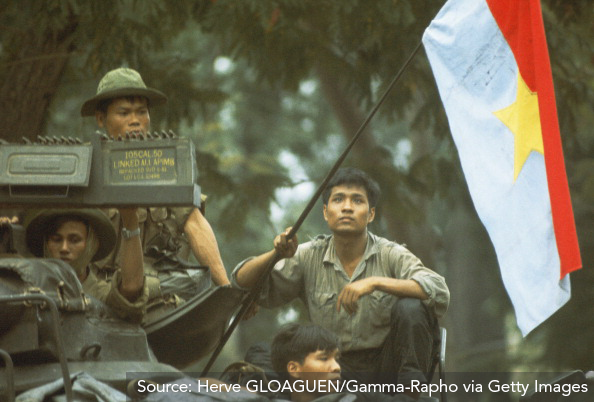 Image 2: Viet Cong soldiers waving NLF flag.
Image 2: Viet Cong soldiers waving NLF flag.
But in the weeks after liberation, there were already signs that the North would not tolerate an alternative base of power, especially one that included non-communists like the NLF. One top NLF official named Truong Nhu Tang reflected on this while watching the victory parade organized by the communists shortly after they took Saigon. Rather than carry the NLF flag, his troops (divisions) were carrying the Democratic Republic of Vietnam flag, the flag of North Vietnam. He says:
Seeing this, I experienced almost a physical shock. Turning to Van Tien Dung who was then standing next to me, I asked quietly, “Where are our divisions one, three, five, seven, and nine?” Dung stared at me a moment, then replied with equal deliberateness; “The army has already been unified”…“Since when?” I demanded; “There’s been no decision about anything like that.” Without answering, Dung slowly turned his eyes back to the street, unable to suppress his sardonic expression, although he must have known it was conveying too much. A feeling of distaste for this whole affair began to come over me—not to mention premonitions I did not want to entertain.9
At a meeting of northern and southern delegates in the summer of 1976, the decision was made official: the two Vietnams would be merged into a single state, called the Socialist Republic of Vietnam. The decision was made without any meaningful discussion or debate. Some southern delegates objected, saying that people in the south would not easily accept life in a socialist system, but their protests were not heeded.10
“Re-educating” people: Many low- and mid-level civil servants in the old South Vietnam government were replaced by officials from the north. Most of these officials had done work that was not particularly political in nature, like running a school or hospital. But they were still required to spend a few days or weeks in “retraining courses,” in which a
communist cadre carefully explained to his listeners their errors [and] provided them with the fundamentals of a new communist society, peppering his lecture with liberal citations from the internationalist Marxist canon and Ho Chi Minh. He then repeated the importance of following the correct path before letting everyone go.11
For soldiers and higher-ranking officials in the South Vietnam government, and for anyone else viewed with suspicion, “re-education” was longer and more severe. Some people spent several years in camps. They were subjected to torture and brainwashing and forced to do hard labour in inhospitable areas of the country. Some who were taken away to the camps were never seen again.12 In total, about a million people in the former South Vietnam were subjected to some form of “re-education.”
 Image 3: Vietnamese man in a re-education camp (other camps were more like prisons).
Image 3: Vietnamese man in a re-education camp (other camps were more like prisons).
Some southerners described their time in these camps as the first time they interacted with northerners in many years. Tran Tri Vu, who spent four and a half years in six re-education camps, describes this in his memoir, Lost Years:
Our generation in the South was suddenly charged with wrongdoing because we had not lived in the North, had not been used to the way of reasoning of the Northern people, had not accepted their ideology. Our skin was the same color, we spoke the same language, our ethnic origin and geographic location were the same, and yet we were completely different from them. When Northern soldiers poured into the South, they had appeared to our eyes as country folks who had strayed into a big town…Living in their company, observing their way of life and thinking, and especially experiencing our treatment in the camp, we had come to realize that between us and them was a barrier that could never be overcome.13
Finding the “bad elements”: One tool the government used to identify so-called “bad elements”—those who were opposed to the North’s communist ideology—was the personal dossier. These were written biographies that included a person’s name and the names of his or her family members, as well as his or her ethnicity, religious affiliation, and current job. The government used this information to categorize people as “good” or “bad.” If a person had a sister, father, or uncle who had worked with the French, American, or South Vietnamese government, for example, he or she would likely be put in the “bad” category. Similarly, if someone’s family owned a business or other property, it meant that person was a capitalist, which was also bad. In total, the number of people who were believed to have such affiliations was estimated to be one-third of the south’s population.14
People from families that had shown loyalty to the communist cause and liberation—especially those with a family member who died fighting South Vietnam and/or the Americans—were usually put in the “good” category. Unlike the “bad elements,” these people had opportunities under the new system, such as getting a good job working for the government or military, or better access to a university education.15
Monitoring and silencing alternative forms of thinking and belief: The media, schools, and religious institutions were brought under government control. All of these represented potential challenges or alternatives to socialism and were therefore seen as threats. Newspapers were shut down and the government started keeping records of who attended religious services. The government was especially suspicious of Christianity, which it saw as a holdover from the colonial years. But even non-European religions like Buddhism were viewed with suspicion. Some religious buildings were closed down or required to place a portrait of Ho Chi Minh on their altars.16 The government also burned books that it felt were not supportive of the revolution, and it replaced many teachers in the south with teachers from the north, who they believed would be more loyal.
Building a Socialist Economy
In addition to consolidating political control, the Vietnamese government introduced a socialist, centrally planned economy in the south. (This system was already in place in the north.) In such economies, people are often discouraged or forbidden from owning private property. Instead, property is “collectively” owned and controlled by the government, which makes decisions about what to produce and how much to distribute to different groups. Introducing this system in the south led the government to take several actions:
Cracking down on capitalism: The government confiscated (took away) private property from its owners and “nationalized” (took control of) many southern businesses. One of the groups most affected was the ethnic Chinese minority, known as the Hoa. Many Hoa in the south profited during the period of French colonization, and continued to play a major role in South Vietnam’s capitalist economy. However, they generally avoided politics and refrained from aligning themselves too closely with the South Vietnamese government.
Nevertheless, by the late 1970s two events made the Hoa a target: failing economic policies, which made them a convenient scapegoat; and the Vietnam government’s deteriorating relationship with China.17 According to Goscha, 70 percent of the capitalists who were targeted in the post-war period were Chinese.18 The scale of their losses was staggering, estimated at US$2 billion.19 As journalist Barry Wain commented in 1979, harassing the Hoa and confiscating their property benefited the government in two ways: it removed resources from a group it suspected of disloyalty; and it profited from the assets it confiscated, including, says Wain, “considerable quantities of gold that [had] been buried in backyards since the communist takeover.”20
De-urbanizing the population: The population of cities like Saigon swelled in size during the war as people fled the fighting and bombing in rural areas. After reunification, the government worried these cities would become sites of social unrest, and it encouraged people to return to their hometowns. Some did so voluntarily, but others were relocated against their will to New Economic Zones (NEZs) set up by the government. These zones were usually located in remote highland areas, where living conditions were harsh. According to one account:
people were transported to the NEZs and told to produce crops with no equipment guidance. The people received no food and were reduced to eating the leaves off the trees and bushes. There were well known cases of people [in] the NEZs dying from eating manioc leaves that they had cooked.21
Many people “escaped or bribed their way back to the city [and the] new economic zones came to be widely perceived as places of internal exile.”22 In addition, many of the highland areas where NEZs were set up were inhabited by Vietnam’s indigenous peoples, and they generally did not welcome outsiders who viewed them as “backwards and uneducated.”23
Collectivizing peasants: About half of all rural families in the south were organized into agricultural collectives. These collectives put several families together into a single unit that was expected to combine what they produced and turn over any surplus (anything above what they needed for their basic and immediate consumption) to the government. The government distributed this surplus to people elsewhere in the country. In collectivized farming, people were rarely rewarded individually for their hard work. Thus, while collectives were supposed to make the rural economy more productive, they often had the opposite effect. Says Goscha: “collectivizing agriculture and setting uncompetitive prices … erased incentives for production in the countryside. Rather than producing more, Vietnamese peasants … simply cultivated enough land upon which to live rather than have to turn over any surplus to the state at fixed prices (i.e. at a loss).”24
 Image 4: Vietnamese peasants.
Image 4: Vietnamese peasants.
With decreasing productivity, the economy contracted. By the late 1970s, Vietnam, once a major rice producer, was experiencing cases of famine or near famine. It was becoming clear that the socialist economic experiment in the south was failing.
Resistance and Escape
Southerners were not entirely passive in responding to these changes. Some accepted and adapted to life under the new system, whereas others found “safe” ways to push back, especially against the new economic system (although there were no safe ways to push back against the political system). Others chose to leave, even when doing so was fraught with danger and uncertainty.
Everyday resistance: Some peasants who were forced to join rural collectives resisted in ways that were quiet and indirect. They did this in order to avoid punishment, a tactic anthropologist James Scott calls “weapons of the weak.” This includes small but persistent actions or inactions by those who lack formal power to push back against those who have formal power. These “everyday forms of resistance” included, for example, not putting forth one’s full effort to produce for the collective in order to save time and energy to grow food for one’s own family. Another example was delaying delivery of grain or livestock to government authorities.25 These tactics became increasingly common, and by the early 1980s there was a noticeable “southern resistance” to collectivized agriculture.26 It should also be noted that peasants in the north were also using these resistance tactics, and many eventually withdrew from collectives.
Fleeing Vietnam: Some who were targeted by the government, or who generally faced worsening conditions, made the decision to leave. The first wave of departures was the 140,000 southerners who fled during the fall of Saigon in 1975. These were people who had worked with the Americans, and most were permanently re-settled in the United States. But the departures continued, even without American or other international assistance. Smaller numbers continued to leave Vietnam, many in small and rickety boats that landed in neighbouring countries or territories where they requested asylum. In 1977, approximately 15,000 Vietnamese “boat people” had arrived in Southeast Asian countries. By the end of the following year, the numbers reached alarming levels, quadrupling to 62,000.27 An estimated 70 percent of them were ethnic Chinese.28
By 1979, members of the international community were recognizing that the situation had become a humanitarian crisis. There were two main reasons for their concern. The first was the refugees’ safety and welfare. About 10 percent of the “boat people” died at sea because of drowning, attacks by pirates, a lack of food and water, or disease due to the poor conditions on their boats. Many more barely survived. The United Nations High Commissioner for Refugees, Poul Hartling, called it “an appalling human tragedy.”
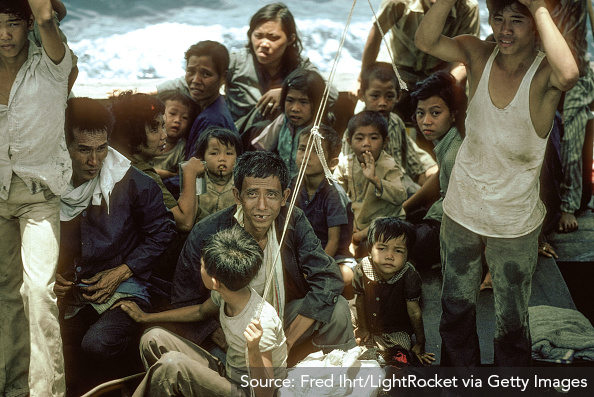 Image 5: Boat people from Vietnam.
Image 5: Boat people from Vietnam.
The second issue was the uncertainty about where these refugees could be resettled. The countries where they sought first asylum—that is, the places where they landed first—were mostly in Southeast Asia. But none of these countries had signed the United Nations 1951 Convention Relating to the Status of Refugees. Therefore, they had no legal obligation to grant asylum.29 As such,
None of the countries receiving Vietnamese boat people gave them permission to stay permanently and some would not even permit temporary refuge. Singapore refused to disembark [allow to go ashore] any refugees who did not have guarantees of resettlement [in other countries] within 90 days. Malaysia and Thailand frequently resorted to pushing boats away from their coastlines. When Vietnamese boat arrivals escalated dramatically in 1979, with more than 54,000 arrivals in June alone, boat ‘pushbacks’ became routine and thousands of Vietnamese may have perished at sea as a result. At the end of June 1979 … Indonesia, Malaysia, the Philippines, Singapore, and Thailand … [announced] that they had “reached the limit … and would not accept any new arrivals”.30
Similarly, there were reports of refugee boats in distress being neglected by other ships passing them, violating the “fundamental rule of the sea that passing ships must stop to rescue people from vessels in trouble.”31
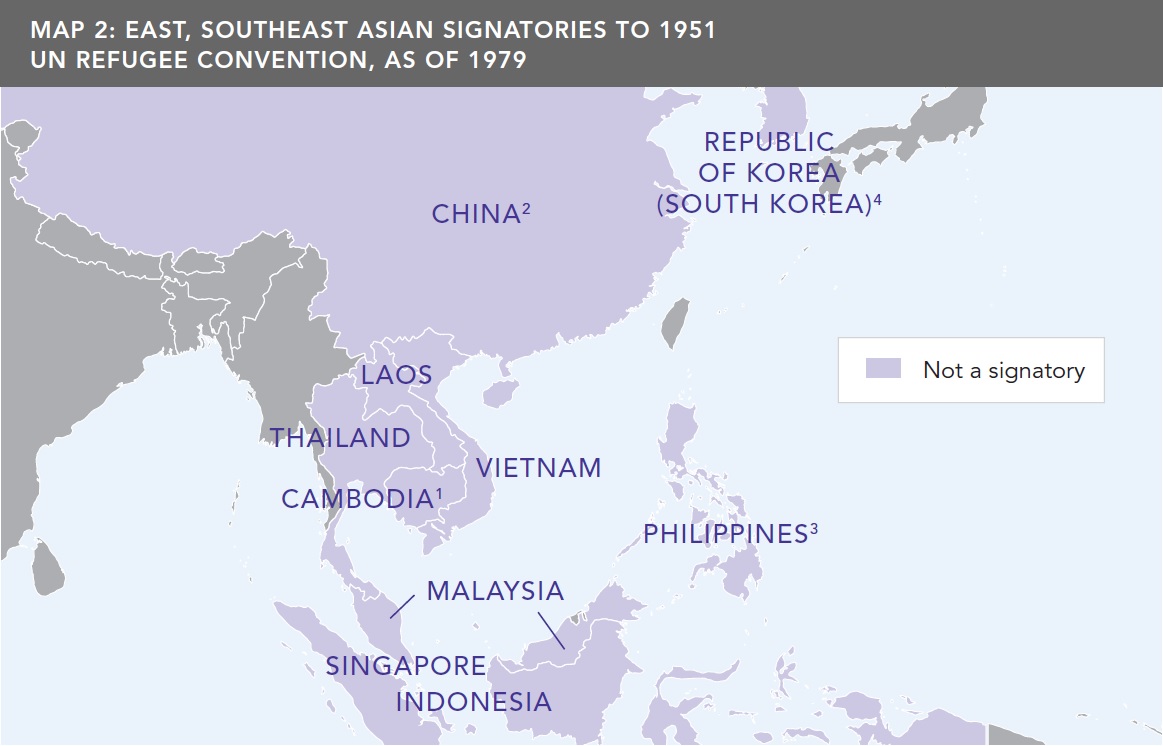 Map 2: East, Southeast Asian Signatories to 1951 UN Refugee Convention, as of 1979.
Map 2: East, Southeast Asian Signatories to 1951 UN Refugee Convention, as of 1979.
In response, the United Nations organized an emergency meeting to find a solution to the immediate crisis. What resulted was a three-way agreement:
- Country of origin (Vietnam): Those fleeing Vietnam were so desperate to leave that they resorted to using illegal means. They often had to bribe police and border agents to allow them to leave, and had to sell almost all their valuables in order to pay smugglers to get them out of the country.32 In most cases, these officials and smugglers were not primarily concerned with the safety of the refugees. Therefore, as part of the new UN agreement, Vietnam agreed to the Orderly Departure Programme, which involved taking measures to make these departures safe, orderly, and legal.
- Countries of resettlement: At the time of the UN meeting, only about 9,000 Indochinese refugees per month were being permanently resettled—a pace far slower than what was needed to keep up with the number arriving in neighbouring countries and territories. Australia, Canada, France, and the United States led a group of more than 20 countries in speeding up the process to 25,000 per month (see Figure 1). From July 1979 to July 1982, these countries settled almost 625,000 refugees fleeing conflict not only in Vietnam, but also in Cambodia and Laos.33
- Countries of first asylum: The five Southeast Asian countries that had been the site of first asylum for many of the boat people (Indonesia, Malaysia, the Philippines, Singapore, and Thailand) agreed to provide temporary asylum under two conditions: that Vietnam implement the Orderly Departure Programme, and that other countries act more quickly to provide the refugees permanent homes (see Figure 2).
 Figure 1: IndoChinese Boat People's Country/Territory of First Asylum, 1975-95.
Figure 1: IndoChinese Boat People's Country/Territory of First Asylum, 1975-95.
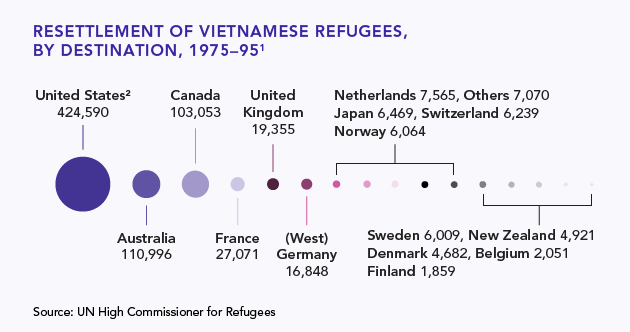 Figure 2: Resettlement of Vietnamese Refugees, by destination, 1975-95.
Figure 2: Resettlement of Vietnamese Refugees, by destination, 1975-95.
These measures did not totally end the “boat people” crisis, but they did help to prevent an even larger humanitarian crisis that was brewing by the late 1970s. Nevertheless, says Goscha, this “internal hemorrhaging” of Vietnamese society “was proof that national reconciliation,” until that point, “had been a failure.”34
Putting Post-War Vietnam in Context
For any country recovering from years of civil war, stabilizing and rebuilding can be overwhelming. Vietnam’s ability to do this was slowed by two additional challenges. The first was economic; after withdrawing from the country in 1975, the United States imposed a trade embargo on Vietnam, “cutting off the war-wrecked country not only from US exports and imports, but also from those of other nations that bowed to American pressure.” In addition, the United States pressured other international bodies to deny assistance to Vietnam.35
The second challenge was geopolitical. Two weeks before Vietnam’s reunification, the government in neighbouring Cambodia was overthrown by the Khmer Rouge, a communist regime often described as genocidal and murderous. Although both countries were led by communist governments, members of the Khmer Rouge leadership were suspicious of Vietnam, believing that it wanted to expand its control over Cambodia. The Khmer Rouge began launching attacks against Vietnam along their shared border. In 1977, Vietnam retaliated with military strikes of its own, and by late 1978, began a more vigorous assault on the Khmer Rouge. In January 1979, it overthrew the Khmer Rouge and replaced it with a government that was more favourable toward Vietnam. Later that year, China, as punishment for the overthrow of its ally, the Khmer Rouge, “launched a brief attack on several northern provinces on Vietnam.”36 These two conflicts were part of a larger group of conflicts known as the Third Indochina War.
Nevertheless, pointing the finger at these other governments did not help Vietnam solve the practical economic difficulties it was facing internally. Following reformist policies being adopted in China and the Soviet Union, Vietnam’s communists launched market-oriented economic reforms that set the country on a course for major changes.
Doi Moi and the “New” New Vietnam
By the early 1980s, Vietnam’s government was coming to realize that communism would not provide a miracle cure for rapidly modernizing the country and growing its economy.37 As Goscha observes, “raw peasant hunger brought the Viet Minh to power in August 1945,” and it could also bring down the communists 50 years later.38 In 1986, Vietnam introduced a series of market reforms called doi moi (“renovation”). Central planning was abandoned and the economy was opened up to market forces of supply and demand. In rural areas, the government ended collectivization and allowed farmers to keep what they grew and sell it at markets.39 Rice production rebounded dramatically, making Vietnam one of the world’s largest rice exporters. Exports of tea and coffee also grew significantly. In the cities, new factories began producing items like shoes, clothes, and computers that would be sold in other countries.40 By 2001, Vietnam’s economy was growing rapidly at about eight percent per year.
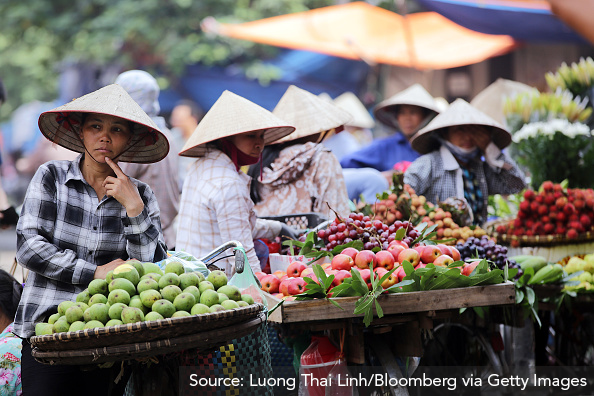 Image 6: Vietnamese peasants selling their goods at a market.
Image 6: Vietnamese peasants selling their goods at a market.
Although the benefits of doi moi have been uneven, with some benefiting more than others, almost everyone has seen improvements in their lives. For example, at the end of the war, 70 percent of the people in Vietnam were living below the official poverty line. Today, that number is estimated to be less than 20 percent. And Vietnam’s literacy rate is now an impressive 95 percent. The reforms have also raised the status of some southerners, especially those with business skills; whereas they were once labelled “bad elements” because of their connection with capitalism, the government came to see them as playing an important role in boosting the country’s economy.41
Of course, doi moi has had some downsides. In addition to growing social and economic inequality, corruption (including by members of the ruling Communist Party) has become a serious problem. In addition, there have been no corresponding reforms of the political system. However, there are at least two signs that many Vietnamese people both within and outside the country recognize as positive.
Optimism about the Future: In 2014, a survey of 44 countries (both developing and developed) asked people if they thought their children would be better off or worse off financially than themselves. Vietnam outranked every other country in its optimism about the future, with 94 percent saying they believed their children would be better off (see Figure 3). The same survey asked people: “What would you recommend to a young person who wants a good life, staying or moving abroad?” Eighty-eight percent of people in Vietnam said “staying” (see Figure 4) a stark difference from the way so many felt in the late 1970s.42
 Figure 3: Vietnamese Optimistic about the Next Generation's Economic Future.
Figure 3: Vietnamese Optimistic about the Next Generation's Economic Future.
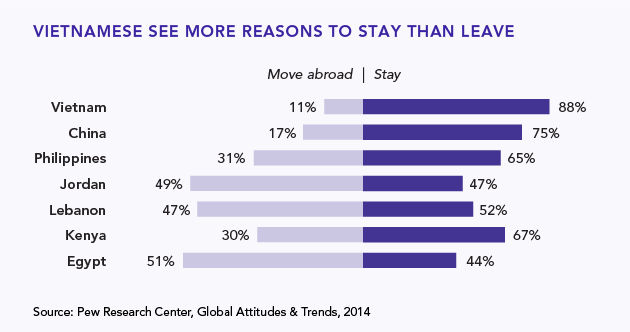 Figure 4: Vietnamese see more reasons to stay than leave.
Figure 4: Vietnamese see more reasons to stay than leave.
Return of Overseas Vietnamese: Some of the people who left Vietnam 40 years ago are now returning. The same is true of some of their children, who have grown up in countries like Australia, Canada, France, and the United States. Their understanding of Vietnam has been shaped from the outside, including by their parents and grandparents who may have left under distressing circumstances. Whatever they may have learned from their elders, they are lured by a sense that they can benefit from Vietnam’s energy and rapidly growing economy. This (re)connection with the Viet kieu (overseas Vietnamese) has been encouraged by the Vietnamese government, which hopes these overseas Vietnamese will bring investment and the types of capitalist businesses the communists once disapproved of so strongly. The return migration has also been facilitated by Vietnam’s re-establishment of relations with its old adversary, the United States, and other western countries the Viet kieu have called home.
Although the political system has been much slower to open up, the Vietnamese government, still run by the Communist Party, seems to have learned the lesson that many other ruling communist parties also learned: that one way to win over your population is by giving them less collectivization and “re-education,” and more opportunities to enjoy the same things that people in other countries enjoy, like cars, smartphones, and family vacations.
Vietnamese Youth: Writing the Next Chapter
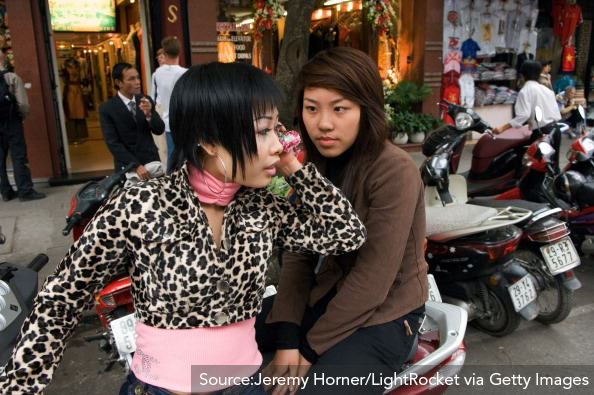 Image 7: Vietnamese youth on a motorbike in Hanoi.
Image 7: Vietnamese youth on a motorbike in Hanoi.
As noted earlier, the wounds inflicted during civil wars take a long time to heal. Has Vietnam healed those wounds and finally achieved reconciliation between northerners and southerners? The optimism Vietnamese people feel about their future suggests that the war may not be the most important issue for a majority of the country’s people. Indeed, the survey mentioned above suggests a country that is looking ahead more than it is looking to the past. When Barack Obama visited the country in 2016, the U.S. president’s comments reflected this mood as he spoke to a crowd in the capital city of Hanoi. “This is your moment,” he said, assuring them that as they pursued the future they wanted, the United States—the country that fought Vietnam for more than two decades —would be right there along with them.43
But on the issue of the war, there are still lingering differences between northern and southern perspectives:
For older Vietnamese, the war and its aftermath are emotional topics remembered and recounted with selective detail. Southerners, for example, tend to be familiar with and sympathetic to the perilous, often tragic experience of the boat refugees, an exodus in which, by some estimates, as many as 300,000 people perished at sea. Northerners, on the other hand, sometimes show only a vague awareness and express a harsh viewpoint, some calling those who left cowards who abandoned Vietnam in hard times.44
What do younger Vietnamese think? The answer to this question is significant; almost 70 percent of the country’s population was born after the war, and their memories of that period of the country’s history are mostly inherited from their parents and grandparents, or learned through what they are taught in school. In fact, the post-war generation is “the first generation since French colonialism to have been raised during a time of independence and peace.”45 Many urban youth tell international reporters that they are not that interested in learning about the war, and would prefer to spend their time doing the kinds of things that young people in other countries like doing, such as riding skateboards, shopping with friends, hanging out in cafes, and making plans for where they will study abroad—all things that are available to them thanks to the economic reforms and opening up afforded by doi moi.
These benefits, however, often feel out of reach for many rural youth. While the reforms that have been underway since 1986 have generally benefited Vietnam as a whole, it is clearly the case that urban, well-connected families have benefited much more. This includes members of the government. This is not to suggest that rural Vietnamese are more buried in the past than their urban counterparts; it may suggest, however, that a new division is starting to open in Vietnamese society—not between north and south, but rather between those who are experiencing Vietnam’s economic success and bright future and those who are still aspiring to it.
Acknowledgement
The Asia Pacific Foundation of Canada (APF Canada) is grateful to Christopher Goscha, professor of history at the University of Quebec at Montreal, who provided helpful comments and suggestions in developing this background reading. Professor Goscha is the author of two recent books on Vietnamese history: The Penguin History of Modern Vietnam (Penguin UK, 2016) and The Making of Modern Vietnam (Basic Books, 2016).
APF Canada is responsible for the content of this background reading.
We gratefully acknowledge the financial support of the Province of British Columbia through the Ministry of Education.
End Notes:
For a full list of citations, please see the PDF version of this document.
Primary Documents
Interactive Timeline
Multimedia
Quizzes
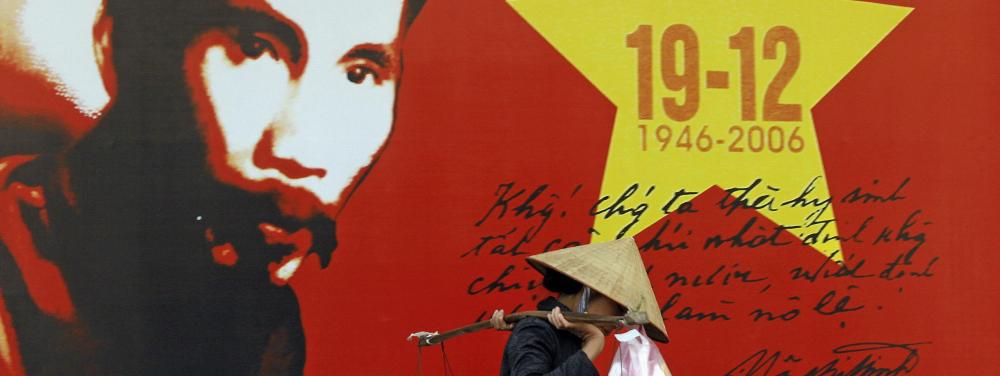
-
Quiz for Vietnam After the War
Think you know the who, what and why of Vietnam after the war? Take this quiz to find out!
Start Quiz -
Quiz for Vietnam After the War - 1 of 4
SubmitTrue or False? Immediately after the war ended in 1975, Vietnam got a much-needed foreign assistance from the U.S. government in the form of war reparations.
TrueFalse -
Quiz for Vietnam After the War - 2 of 4
SubmitThe government of Vietnam set up New Economic Zones in post-war Vietnam. These were:
Places where market reforms were encouraged.Usually located in remote areas.Areas where southern capitalists could keep their businesses.Areas where people fleeing the country could be safe until their departure. -
Quiz for Vietnam After the War - 3 of 4
SubmitTrue or False: Vietnam’s Southeast Asian neighbours were eager to grant asylum to the “boat people” because they had signed the United Nations Refugee Convention
TrueFalse -
Quiz for Vietnam After the War - 4 of 4
SubmitAfter 10 years of economic crisis, the Vietnamese government introduced a series of market reforms. What was is the name commonly used for this reform program?
-
Quiz for Vietnam After the War - Results
Your score: out of 4 Correct!Take it Again
In the News
- BOAT PEOPLE/REFUGEES
- RE-EDUCATION CAMPS
Teacher Resources
Overview
We invite teachers to share ideas for using these materials in the classroom, especially how they can be used to build the curricular competencies that are prioritized in the new B.C. curriculum.
By registering with us, you will be able to access the for-teachers-only bulletin board. Registration will also allow us to send you notifications as new materials are added, and existing materials are updated and expanded.
For the sign in/register section:
Please register below to access the teachers’ bulletin board, and to receive updates on new materials.
Sign-in/Register
Registration Info
We want parts of this section to be secure and accessible to teachers only. If you’d like to access to all parts of the Teacher Resources, please sign-in or register now.
Sign-in/Register
